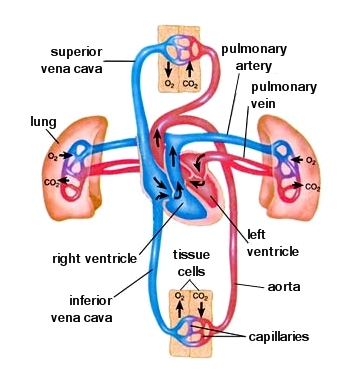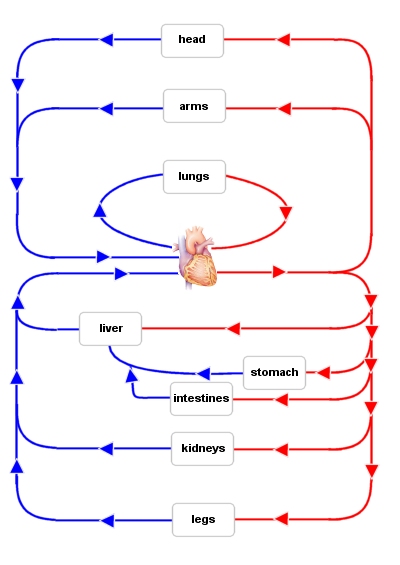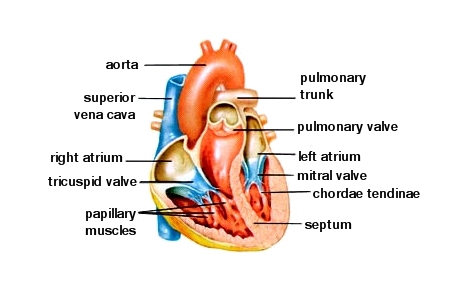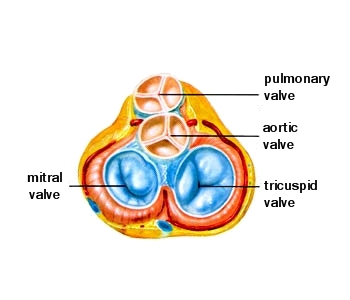Circulatory System
The purpose of the circulatory system is to provide mass flow of materials from one part of the body to another, i.e. it is an internal transport system. It has three basic characteristics:
- Circulatory fluid, i.e. blood which transports the materials.
- A pump, e.g. the heart.
- Tubes through which the blood can circulate, i.e. blood vessels (vascular)
The human blood circulatory system is a double circulation which means that the blood passes through the heart twice during every full circulation, thus we can consider:
- Pulmonary circulation system.
- Systemic circulation system.
The pulmonary circulation system, shown in Fig. 1 below, carries deoxygenated blood through the lungs to be oxygenated. On return through the left side of the heart, the oxygenated blood is then pump through the systemic circulatory system to tissues throughout the body.
In both of the systems, there are principally three types of blood vessel:
- Arteries - transport oxygenated blood from the heart to areas of the body.
- Veins - transport blood to the heart to be reoxygenated.
- Capillaries - transport blood to different areas of tissue.
Note that the pulmonary artery is the only artery that carries deoxygenated blood and the pulmonary vein is the only vein that carries oxygenated blood.
Blood Vessels
Arteries
These receive blood from the heart. They are relatively wide (diam 0.0 1-10 mm) and posses elastic fibres in order to smooth out fluctuations in pressure between systole (heart contraction) and diastole (heart relaxation).
Arteries consist of a fibrous outer layer, a elastic middle layer containing circular muscle and a smooth endothelial inner layer. The larger arteries contain more elastic tissue than circular muscle so that they can absorb the greater pressure surges brought about by heart contractions. Arterioles have more (smooth) circular muscle than elastic tissue.
Capillaries
These pressure fluctuations decrease until there is a steady flow in the capillaries.
Capillary walls are one cell thick and not extensible (some are so thin that erythrocytes are squashed while passing through them). They are permeable to dissolved food, gasses, nitrogenous waste etc. and even some cells
Although the capillaries are thin they represent a massive area resulting in an enormous reduction in blood pressure. The capillary network is very dense reaching most cells and even penetrating liver cells.
Their size is controlled by nervous stimulation which reduces their aperture and Histamine which increases it.
Veins
These return blood to the heart. They are wider than the arteries with a thinner relatively inextensible walls as the elastic tissue of the arteries is replaced by fibrous tissue.
Venous blood is under very low pressure having been slowed down in the capillary bed of the various body organs and requires extra mechanisms to facilitate return to the heart.
Many veins contain one way valves (similar to semi-lunar veins in the heart) that prevent backflow as the blood is returning to the heart. Venous return occurs as a result of:
- Pressure (squeezing) on the veins by the surrounding muscles. The valves ensure that the resultant movement is unidirectional.
- Breathing. During Inspiration., the abdominal organs have a relative positive pressure while the thorax simultaneously has a relative negative pressure.
The flow of blood to an organ is controlled by muscle fibres in the walls of arterioles and pre-capillary sphincters. These are controlled by the sympathetic nervous system and also by the local concentration of chemicals such as oxygen and lactic acid.
In the capillary, plasma is forced out under pressure through small pores and re-enters at the venous end of a capillary by osmosis. Excess fluid is returned via the lymph.




